
|
 |

|
 |
Sharmila Biswas: Antar Yatra has helped me to evolve - Kathakali Jana e-mail: kathakalijana@gmail.com July 13, 2016 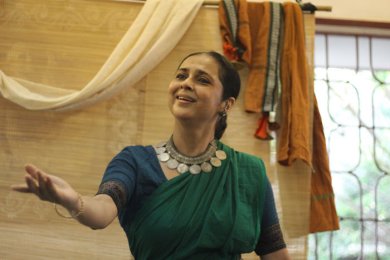 Choreographer Sharmila Biswas's latest work, Antar Yatra, is the tentative journey of a thinking artiste and her process of creating her magical world. Three classical dance forms, songs sung in six languages, multiple voices of the narrator and a tour of seven cities, Antar Yatra is a travel through time, space and eternity. Excerpts from an interview with the choreographer: While Antar Yatra is a personal journey, it is perhaps also the journey of all women artistes across genres and forms? What sources have you used for your research into the private domain of women artistes? I see Antar Yatra as the journey of any person who has sought and found his or her passion. It is not a documentation of artiste's history or social evolution. It is a sharing of my experience with dance and dancers. Many of the thoughts encased in the work have come from woman artistes I have met in my life - Guru Ma Laxmipriya Mohapatra, Sanjukta Panigrahi, Girija Devi, Kalanidhi Narayanan, and many of the seniors who influenced my growing up years. Also, there were Shashimani and Parashmani Mahari, Harapriya Mahari - the Devdasis of Jagannath temple - and many traditional and rural artistes I had the privilege of knowing while I studied different aspects of Odissi dance. Other women artistes, painters, co-artistes, and my students have influenced me. For me, even the dance techniques I evolved are connected with the dancers themselves. It's about the way they look at life, not just the dance they practise. Their instinct for abstraction, humour, colours and joys and sorrows, their myriad moods, these things do not change with time. They were women of the world who are at the same time detached from the lives they live. In the works of scholar Nrisimha Prasad Bhaduri, who is an authority on Pauranic texts, I found enriching references to Apsaras. The analysis of their characters, and his comparison of the Apsaras with Indian theatre's first generation of women actors and dancers was fascinating. Books such as 'Unfinished Gestures' by Davesh Soneji, and another book called 'Bharatanatyam' edited by him, 'Nritya Sumangali' by Saskia C Kersenboom, 'Debadasi' by Bijaini Das, 'Woman of Pride' by Lakshmi Vishwanathan, have all helped me in my understanding of our past. Scholars like Dr. B.M. Sundaram, Dr. V.A.K. Ranga Rao, Debadatta Samanta Shinghar, Kashinath Puja Panda, Damodar Kar and many others have shared their knowledge generously with me. All these have helped me create the right mood for the productiion Antar Yatra. To what extent are you talking about your own choreographic process through this work? I had to understand and make sense out of all those new things and the project had to grow from my sensibility. Each movement essentially had to come out of me. Although it has three forms of dance, I did not want a cut and paste job where one says you do your thing and I do mine and I just supervise the choreography. While that would be safe, perhaps bringing more assured success to the presentation, it would be totally hollow for me. It would not be the learning process, with which I constantly inform myself as a dancer and choreographer. Groping with all the different aspects, trying to put them together, failing, changing many times, confronting the dancers at the rehearsals and telling them that I was clueless - all these have been some of the most humbling experiences of my life. Antar Yatra has helped me to evolve. It has taught me to express thoughts which I never considered as dance ideas, but nevertheless felt had to be expressed by dancers. 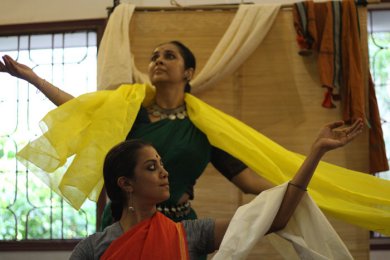 You have used Bharatanatyam and Kuchipudi apart from Odissi. As an Odissi dancer, how have you choreographed the two other forms? I decided to use the three temple dances, supposedly with their origin in Apsaras, of the Coromandel belt. At the beginning of any chorographic process you start by looking for tools and techniques. A technique that is suitable for a linear narrative would not be so for an abstract idea. When one or more forms are used, they are usually presented through contrasts and encounters. In this production, however, they flow together, maintaining their individuality. They join hands to tell a common story. My forte is Odissi. I have never forayed into any other form. But this time I have stepped out of my comfort zone without worrying about whether I would be able to justify the use of the two other forms. While working with two exceptional Bharatanatyam and Kuchipudi dancers, I showed them my movements and invited them to come up with theirs. Both Lakshmi Parthasarathy Athreya and Amrita Lahiri - who are central to this production along with my student Shashwati Garai Ghosh - are thinking dancers whose sensibilities in terms of their own forms are very strong. We often found similarities in movements which pointed towards a probable match in artistic impulses. As for the experiment, I am ready to fall flat on my face by taking risks. At my age I feel the need to create what I want to. There are some other forms - folk dances and puppetry etc, that have crept into this work. Do you feel that they add to the classical feel of your work? All my projects have involved rural/traditional artistes. For these artistes art is woven into their lives and there is no conflict between the two. I identify with the philosophy of such artistes and I feel that there is a comfort zone between them and me in all our interactions. My mind always goes to these expressions as they widen our vision and prompt us to look at our feet. The production has invited shadow puppetry and other folk forms and arts. These have added drama. But each of these forms has undergone changes to blend with the concept and style of dance and music. 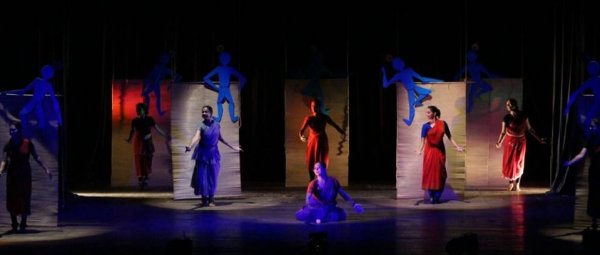 How did you go about creating the music for this layered and multidimensional project? I wanted the concept and the music to grow together. I wanted the music director Srijan Chatterjee to see and hear with me while I was studying and developing the concept, so that there would be no gap, and the concept and music could be as close as possible, with him being a part of the process. This method of working was fruitful and the music will remain one of my greatest joys. Besides, I am thankful to many seniors and artistes - Dr. B.M. Sundaram, Kala Krishna, Prahlad Baral and so many others, who contributed generously. The lyrics are in six different languages, coming from interesting and curious sources. Each song, how we discovered them, how we transformed them to suit the script, is a story. Dr. B.M. Sundaram sang a song, traditionally sung by a group of Devadasis at the time of their initiation. "When the Lord is opening his arms to you, would you still go after this ordinary man?" the lyrics go. I interpreted it as "When the magical world awaits you, would you still look for the mundane?" Costumes are a major concern for you. How have you addressed this with regard to this work, where dancers in three forms come together along with other dancers - including yourself - who play the sutradhars? Antar Yatra, beautifully stated by Sheela Balaji, showcases the dances of the Coromandal belt, the east coast of India. One form melts into the next. This has influenced my choice of shades and design. I have tried to create moods of each scene with colours. For a production based on abstract ideas, colours, styles and other aharya elements play a very important role. I tried to understand and implement these in this work much more than in any of my earlier productions. Beyond this work and beyond your form, what is your vision for choreography in Indian dance forms? What saddens me today is that dance is becoming identified as showbiz. Classical dance is a chamber art that is all about intimate communication. I am scared when people look for volume and mass. This is not how classical dance is meant to grow. Surely laser lights and spectacle are not the test for classical dance. The artistes' vision is shrinking, and with it the audience's imagination. I feel that artistes need to perform less and create more. We need to look at our dance and create spaces for ourselves. As far as I am concerned, I do not work with any future vision of growth. Each work, whether it is a new production, or a new technique for class is a discovery, a step, and it excites me immensely. And the path shows itself. 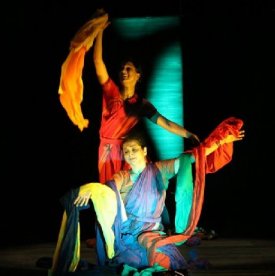
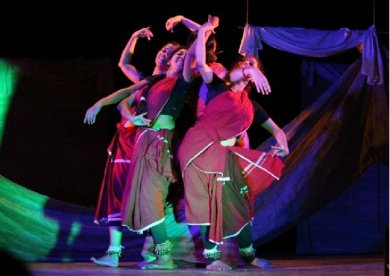
How has Antar Yatra: The Journey Within, helped you grow as an artiste? For me, each of my productions is a learning process. This work has given me the opportunity to look at a large canvas. When I attempted to study the different aspects of Andhra and Tamil traditions, I not only learnt the history of the evolution of the classical dance forms of the south but also about the music and other creative expressions of the regions. Indirectly, it enriched my understanding of Odissi also and put it in context.This has been a great opportunity for me to evolve as a dancer and choreographer. Antar Yatra would not have been possible without the financial and moral support of Sheela Balaji and Aim for Seva. It is indeed beautiful to feel how concern for education and art can combine, to create something worthwhile. It makes for a better future. Contact Sharmila Biswas: ovmcal@gmail.com Post your comments Unless you wish to remain anonymous, please provide your name and email id when you use the Anonymous profile in the blog to post a comment. All appropriate comments posted with name & email id in the blog will also be featured in the site. |